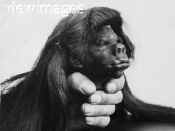Doc Bwana's
House of Shrunken Heads
presents
Shrunken Head
Gallery I
All the images of heads in
these special galleries were sent to
me by an internet friend who is a serious student of the tsantsa. Out of
respect
for his generosity, and out of consideration for the fact that shrunken heads
are worthy
of anthropological study, we have decided to dispense with the humorous approach
in these four galleries, and present a more serious look at shrunken heads.
This traditional tsantsa
has the characteristic
sewn-lip trade mark of the South American shrunken head
The Jivaro believe that the life force of a slain enemy is transformed
into an avenging spirit called a muisak which will seek vengeance
among the living. In order to trap the avenging spirit within the head,
the eyes are shut, the lips are sewn tight, and the face is blackened
with charcoal so that the muisak cannot see out.

The best-made shrunken heads are about the size of a
man's fist. As in any craft, shrunken heads can either be
well or poorly made, depending on the skill of the person
who is making them. This example is a very fine specimen.
No one knows for sure when shrunken heads
were first made
or even where the custom began. Head shrinking probably originated
in human prehistory, perhaps as an outgrowth of man's growing
experience with skinning and curing animal hides. Don Juan, the
shrunken head artist, informs us that head shrinking dates back at
least 2,000 years, and allegedly began in South America. He also
says that images of shrunken heads first appeared in the art of the
Incans, and that early Spanish explorers initially thought that the
tsantsa were the heads of a diminutive race of humans!
The wide distribution of head shrinking
makes it difficult to
pinpoint a precise geographical origin for the practice. South
America
is the primary location to which most experts point,
but Africa
and Borneo also have head hunters and some head
shrinking.
Even the ancient Celts were known to ritually
preserve the
severed heads of the dead.
Although shrunken heads are in one sense
mummified human remains,
it would be incorrect to think of Jivaro tsantsa as examples of
embalming.
The technique by which a tsantsa is made differs from the methods evolved
for treating the general dead. A tsantsa is actually a tool which helps
to control
the relationship between the living and the spirit world. It helps to keep that
relationship safe by neutralizing any animosity which the dead may harbor
toward the living.
The process of making a tsantsa involves
much more than
a physical procedure. A whole ritual is involved which takes
a long time to complete. After the actual head is shrunken,
a series of feasts must be held. According to some accounts,
the avenging spirit trapped within the head slowly loses its
anger as a result of these rituals.
Some accounts even state that
the spirit in the head
can eventually be set free. It will then be reborn as a
member of the tribe it originally fought against. In this
fashion, shrunken heads are a way of transforming
enemies into friends. One tribe steals the spirits of its
rivals, and enlists their eventual cooperation.
Shrunken
Head Gallery II
Still more shrunken heads!
Shrunken
Head Gallery III
See Our Newest SHRUNKEN
HEADS1
Just Added 2/3/02!
Shrunken
Head Gallery IV
See More New SHRUNKEN
HEADS1
Added 2/3/02!
Return to the Shrunken Head Museum